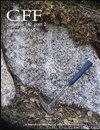奥陶系全球层型的δ13C化学地层学:来自瑞典弗洛ian和Sandbian gssp的地球化学数据
IF 1.2
4区 地球科学
Q2 GEOLOGY
引用次数: 5
摘要
摘要:7个奥陶世全球阶段中有5个阶段的δ13C化学地层学已经发表,但瑞典的Floian GSSP和大部分Sandbian GSSP没有这些数据。现在,从一系列间隔较近的页岩样本中获得的同位素数据弥补了这一信息的缺乏,这些样本分别来自Västergötland的Diabasbrottet的Floian层型和斯堪尼亚的Fågelsång的Sandian层型。尽管这些阶段的基底不能精确地与明显的δ13C偏移水平联系在一起,但以近似四笔石的出现为标志的Floian阶段的基底位于名为LTNICE和BFICE的紧密间隔偏移之间。Sandbian阶段的底部,被定义为笔石细柱线虫的出现水平,刚好低于以前被称为“上库克鲁兹低点”的负偏移,即今天被称为LSNICE。简要讨论了瑞典GSSP中化学地层学与笔石和牙形石生物地层学的关系,以及Baltoscandia、中国和美国的一些同时代关键剖面。结论是,现有数据表明,在这些关系中存在良好的区域协议。本文章由计算机程序翻译,如有差异,请以英文原文为准。
The δ13C chemostratigraphy of Ordovician global stage stratotypes: geochemical data from the Floian and Sandbian GSSPs in Sweden
ABSTRACT The δ13C chemostratigraphy of five of the seven Ordovician global stages has been published previously but no such data have been available from the Floian GSSP and most of the Sandbian GSSP in Sweden. This lack of information has now been remedied by isotope data obtained from series of closely spaced shale samples collected from the Floian stratotype at Diabasbrottet in Västergötland and the Sandbian stratotype at Fågelsång in Scania. Although the bases of these stages cannot be precisely tied to levels of conspicuous δ13C excursions, that of the Floian Stage, which is marked by the appearance of the graptolite Tetragraptus approximatus, is between the closely spaced excursions named LTNICE and BFICE. The base of the Sandbian Stage, which is defined as the appearance level of the graptolite Nemagraptus gracilis, is just below a negative excursion previously known as the “Upper Kukruse Low”, which is nowadays known as the LSNICE. The relations between chemostratigraphy and graptolite and conodont biostratigraphy in the Swedish GSSPs and some coeval key sections in Baltoscandia, China, and America are briefly discussed. It is concluded that the data at hand indicate that there is good regional agreement in these relations.
求助全文
通过发布文献求助,成功后即可免费获取论文全文。
去求助
来源期刊

Gff
地学-地质学
CiteScore
2.80
自引率
10.00%
发文量
11
审稿时长
>12 weeks
期刊介绍:
GFF is the journal of the Geological Society of Sweden. It is an international scientific journal that publishes papers in English covering the whole field of geology and palaeontology, i.e. petrology, mineralogy, stratigraphy, systematic palaeontology, palaeogeography, historical geology and Quaternary geology. Systematic descriptions of fossils, minerals and rocks are an important part of GFF''s publishing record. Papers on regional or local geology should deal with Balto-Scandian or Northern European geology, or with geologically related areas. Papers on geophysics, geochemistry, biogeochemistry, climatology and hydrology should have a geological context. Descriptions of new methods (analytical, instrumental or numerical), should be relevant to the broad scope of the journal. Review articles are welcome, and may be solicited occasionally. Thematic issues are also possible.
 求助内容:
求助内容: 应助结果提醒方式:
应助结果提醒方式:


